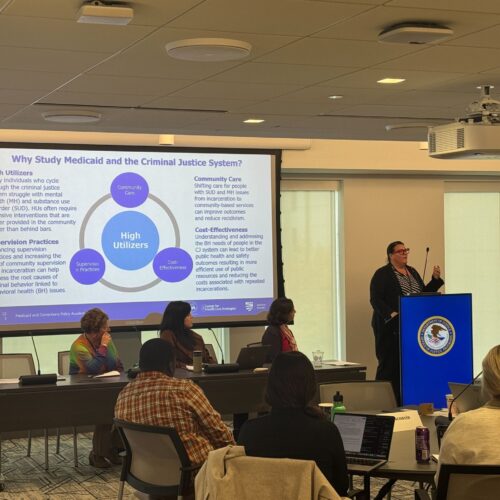Reentry Essentials: Addressing Mental Health Needs among People in the Criminal Justice System
This is the third in a series of posts on aspects of successful reentry. Each post will include curated resources related to the featured reentry topic.
A disproportionate number of people in the nation’s criminal justice system face mental health issues: a Bureau of Justice Statistics report found, for example, that people in U.S. prisons and jails are three to five times more likely to experience serious psychological distress than the general adult population. While there is an overwhelming need to provide effective treatment, challenges exist in quantifying the extent of that need and taking a strategic approach across systems—from law enforcement to community-based reentry services.
Counties Are Stepping Up
At the policy level, state and local governments can work to address the prevalence of people in the criminal justice system who have mental illnesses by increasing cross-system collaboration among policymakers, government agencies, and communities and standardizing the definition of serious mental illness to improve information sharing and inform system developments. This month marks the three-year anniversary of Stepping Up, a national initiative to reduce the number of people in jails who have mental illnesses and provide counties with resources to create sustainable, data-driven plans to address this problem. Since its launch in 2015, more than 430 counties have passed a resolution or proclamation committing to act on this issue.
Read more:
Proven Practices Are Taking Root
At the practice level, criminal justice agencies and service providers can use validated screening and assessment tools to identify criminogenic risk and needs, which can then inform case plans. Tailoring supervision and providing evidence-based and innovative programming to target both criminogenic risk and behavioral health needs can lessen the likelihood of recidivism.
Read more:
- Adults with Behavioral Health Needs under Correctional Supervision: A Shared Framework for Reducing Recidivism and Promoting Recovery
- Collaborative Comprehensive Case Plans
- Guidelines for the Successful Transition of People with Behavioral Health Disorders from Jail and Prisons
- For the Formerly Incarcerated, Peer Mentoring Can Offer Chance to ‘Give Back’
- A Second Chance at Recovery for Women in Wilmington, North Carolina
Continuous Care Is a Priority
Increasing access to medical treatment and continuity of care from prison and jail to the community can ensure that people receive needed mental health care. This includes identifying eligibility for coverage and streamlining access to programs such as Medicaid, Supplemental Security Income, Social Security Disability Insurance, and veterans’ benefits prior to a person’s release from incarceration.
Read more:
- Critical Connections: Getting People Leaving Prison and Jail the Mental Health Care and Substance Use Treatment They Need—What Policymakers Need to Know about Health Care Coverage
- San Diego and Imperial, CA, Counties Work to Enroll People Involved with the Justice System in Medicaid
Innovative Alternatives to Incarceration Are Emerging
Diverting people from incarceration to community-based mental health care is another strategy that communities may consider to address recidivism. Partnerships among law enforcement, courts, mental health agencies, and service providers to prioritize treatment at the front end and avoid further involvement in the criminal justice system can improve both public safety and health outcomes.
Read more:
When returning to their communities from criminal justice settings, people with behavioral health needs face barriers in accessing…
Read MoreNew Hampshire Department of Corrections Commissioner Helen Hanks presents at the Medicaid and Corrections Policy Academy in-person meeting.
Read MoreThe Council of State Governments (CSG) Justice Center has launched the Collaborating for Youth and Public Safety Initiative…
Read More Assigned to the Cloud Crew: The National Incarceration Association’s Hybrid Case Management for People with Behavioral Health Needs
Assigned to the Cloud Crew: The National Incarceration Association’s Hybrid Case Management for People with Behavioral Health Needs
When returning to their communities from criminal justice settings, people with behavioral…
Read More Meet the Medicaid and Corrections Policy Academy Mentor States
Meet the Medicaid and Corrections Policy Academy Mentor States
New Hampshire Department of Corrections Commissioner Helen Hanks presents at the Medicaid…
Read More Six States Commit to Improving Statewide Strategies to Address Youth Crime, Violence and Behavioral Health
Six States Commit to Improving Statewide Strategies to Address Youth Crime, Violence and Behavioral Health
The Council of State Governments (CSG) Justice Center has launched the Collaborating…
Read More Bipartisan Group of 88 Lawmakers Push for Continued Funding for Reentry and Recidivism Programs
Bipartisan Group of 88 Lawmakers Push for Continued Funding for Reentry and Recidivism Programs
A bipartisan group of 88 lawmakers, led by Representatives Carol Miller (R-WV)…
Read More The 10-Year Impact—and Future—of Stepping Up: Facing the Behavioral Health Crisis in Jails and Communities with Real Solutions
The 10-Year Impact—and Future—of Stepping Up: Facing the Behavioral Health Crisis in Jails and Communities with Real Solutions
As the Stepping Up initiative marks its 10th year, America’s justice and…
Read More









